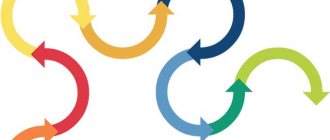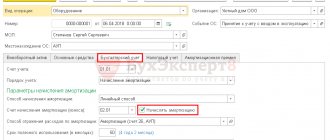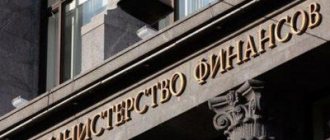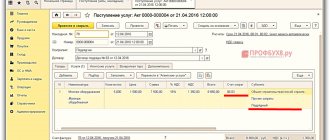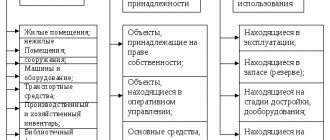Methods for calculating depreciation
Accounting has four options for calculating depreciation. You can learn more about the methods for calculating depreciation in PBU 6/01.
Depreciation should be calculated from the month following the month in which the asset was registered. Let’s say the computer was capitalized in October 2018, the accountant will begin calculating depreciation from November 1, 2018.
Depreciation calculation methods:
- Linear.
- Reducing balance method.
- A method of writing off cost based on the sum of the numbers of years of useful life.
- The method of writing off the cost is proportional to the volume of products (works).
Please note that the listed methods relate to depreciation of fixed assets in accounting. In tax accounting, there are only two ways to calculate depreciation charges - linear and non-linear.
Submit electronic reports via the Internet. Kontur.Extern gives you 3 months free!
Try it
Linear method
Most often, practicing accountants use this method. It is very simple and clear.
To find out the amount of monthly depreciation, you should find the product of the original cost of the asset and the depreciation rate.
Depreciation rate = 1/SPI (months) x 100%.
Example. Funtik LLC registered a Samsung computer. The initial cost is 49,320 rubles. SPI - 5 years (60 months).
The depreciation rate for a Samsung computer = 1/60 * 100% = 1.67.
Monthly depreciation = 49,320 x 1.67% = 823.64 rubles.
Due to rounding, the amount of depreciation in the first months will differ from the amount of depreciation in the last month (the total amount of depreciation for the entire period should not be more than the original cost).
In practice, it is customary to calculate depreciation in a simpler and more accurate way.
Monthly depreciation = 49,320: 60 = 822 rubles.
Submit electronic reports via the Internet. Kontur.Extern gives you 3 months free!
Try it
Reducing balance method
To find out the required amount, you will need the residual value of the fixed assets at the beginning of the year, SPI. Companies also have the right to use an acceleration factor from 1 to 3.
Example. Funtik LLC uses OS in production, the residual value of which as of 01/01/2018 is 49,320 rubles (the same amount is the initial cost). SPI - 60 months. The coefficient is set at 1.3.
2018
49,320: 60 x 1.3 = 1068.60 rubles per month
The amount of depreciation for 2021 will be 12,823.20 rubles (1068.60 x 12).
2019
Residual value as of 01/01/2019 = 49,320 - 12,823.20 = 36,496.80 rubles.
36,496.80: 60 x 1.3 = 790.76 rubles per month.
Depreciation in subsequent years is also calculated in this way. The residual value of the operating system is always taken as a basis. Thus, every year depreciation charges decrease.
Submit electronic reports via the Internet. Kontur.Extern gives you 3 months free!
Try it
Method of writing off cost based on the sum of the numbers of years of useful life
The calculation is based on the initial cost and the sum of the number of years remaining until the end of the investment project.
Example. Funtik LLC uses OS in production, the initial cost of which is 49,320 rubles. SPI - 48 months (4 years). Depreciation is accrued from 01/01/2017.
First, let's determine depreciation rates.
2017 = 4 / (1 + 2 + 3 + 4) x 100% = 40%.
2018 = 3 / (1 + 2 + 3 + 4) x 100% = 30%.
2019 = 2 / (1 + 2 + 3 + 4) x 100% = 20%.
2020 = 1 / (1 + 2 + 3 + 4) x 100% = 10%.
This method allows you to write off most of the cost of the OS in the early years.
The amount of depreciation is determined by multiplying the original amount by the calculated rate.
Depreciation amount for 2021 = 49,320 x 40% = 19,728 rubles.
Monthly depreciation in 2021 = 19,728: 12 = 1,644 rubles.
The method of writing off the cost in proportion to the volume of products (works)
With this method, quantitative indicators of production (pieces, kilograms, etc.), the initial cost and the planned productivity of the operating system are taken as a basis.
Example . Pound LLC produces spare parts on the A458 machine. The machine was purchased in April 2021 and immediately put into operation. The initial cost of the A458 machine is 589,000 rubles. Over the entire period of use, it is planned to produce 350,000 units of products on this machine. In May, the machine produced 4,200 parts, in June - 3,100 units.
Depreciation in May = 589,000: 350,000 x 4,200 = 7,068 rubles.
Depreciation in June = 589,000: 350,000 x 3,100 = 5,216.86 rubles.
Submit electronic reports via the Internet. Kontur.Extern gives you 3 months free!
Try it
Depreciation of fixed assets
Published in the issue: Accounting newspaper No. 20 / 2002
As already reported, the DIS Publishing House has published the 3rd edition of the expanded and revised book by Geits I.V. “Accounting for fixed assets”, which has gained popularity and is considered one of the best in this area of accounting.
Below we present to your attention a fragment from this manual.
IN
In accordance with paragraph 48
of the Accounting Regulations,
the cost of fixed assets owned by the organization is subject to repayment by charging depreciation on them during their useful life.
According to paragraph 17 of PBU 6/01
Depreciation is not charged for the following fixed assets owned by the organization:
- residential facilities (residential buildings, dormitories, apartments, etc.);
- external improvement facilities and other similar forestry, road facilities, specialized navigation facilities, etc. objects;
- productive livestock, buffaloes, oxen and deer;
- perennial plantings that have not reached operational age;
- objects whose consumer properties do not change over time (land plots and environmental management facilities).
At the same time, depreciation (not depreciation) is accrued for them and reflected in off-balance sheet accounts (010 “Depreciation of fixed assets”).
Clause 17 PBU 6/01
It is noted that non-profit organizations charge depreciation on all fixed assets.
The current edition of the Methodological Guidelines for Accounting for Fixed Assets
It is also stipulated that depreciation is not accrued for:
- transferred by decision of the head of the organization of fixed assets for conservation, the duration of which cannot be less than three months;
- objects related to the film fund, stage and production facilities, exhibits of the animal world in zoos and other similar institutions;
- mobilization capacities (unless otherwise provided by law).
The objects for calculating depreciation are not only objects of fixed assets that are in the organization under the right of ownership, but also those objects that are under the rights of economic management and operational management.
If the ownership of buildings, structures and other real estate subject to state registration is not registered in the prescribed manner, then depreciation is not calculated until this right is registered (letter of the Ministry of Taxes and Taxes of the Russian Federation dated April 28, 2000 No. VG-6-02 / [email protected] “On the issue of calculating depreciation charges”
).
Methods for calculating depreciation
Clause 18 PBU 6/01
(as amended by Order of the Ministry of Finance of Russia dated May 18, 2002 No. 45n) also establishes the possibility of one-time attribution to production costs (sales expenses) of fixed assets worth no more than 10,000 rubles per unit or another limit established in the accounting policy of the organization based on technological features , as well as purchased books, brochures, etc.
publications In accordance with paragraph 18 of PBU 6/01,
depreciation on fixed assets owned by the organization is calculated in one of the following ways:
- linear;
- reducing balance method;
- the method of writing off the cost by the sum of the numbers of years of useful life;
- by writing off the cost in proportion to the volume of products (works).
The use of one of the methods for a group of homogeneous fixed assets must be carried out throughout the entire useful life of the objects included in this group.
Clause 18 PBU 6/01
(as amended by Order of the Ministry of Finance of Russia dated May 18, 2002 No. 45n) also established the possibility of one-time attribution to production costs (sales expenses) of fixed assets worth no more than 10,000 rubles per unit or another limit established in the organization’s accounting policy based on technological features, as well as purchased books, brochures, etc. publications
The cost of such objects is written off as they are released into production or operation. However, in order to ensure the safety of these objects in production or during operation, the organization must organize proper control over their movement.
In practice, for each chosen option for writing off the cost of fixed assets, the annual and monthly depreciation rates are determined.
The annual depreciation rate is calculated:
with the linear method
- based on the original cost (replacement value - in the case of revaluation) of an object of fixed assets and the depreciation rate calculated based on the useful life of this object;
with the reducing balance method
- based on the residual value of the fixed asset item at the beginning of the reporting year and the depreciation rate calculated based on the useful life of this item and the acceleration factor established in accordance with the legislation of the Russian Federation;
when writing off the cost by the sum of the numbers of years of its useful life -
based on the original cost (replacement value - in case of revaluation) of the fixed asset object and the ratio, in the numerator of which the number of years remaining until the end of the service life of the object, in the denominator - the sum of the numbers of years of the term object services.
In seasonal production, the annual amount of depreciation on fixed assets is accrued evenly during the period of operation of the organization in the reporting year.
Directly, depreciation is calculated monthly, regardless of the above method applied, in accordance with the monthly depreciation rates calculated at 1/12 of the annual amount.
Depreciation is calculated in a slightly different manner when the cost is written off in proportion to the volume of production (work).
In this case, depreciation charges are calculated based on the natural indicator of the volume of production (work) in the reporting period and the ratio of the initial cost of the fixed asset item and the estimated volume of production (work) for the entire useful life of the fixed asset item.
For all options, depreciation rates are determined depending on the useful life of fixed assets.
Under the useful life, in accordance with paragraph 4 of PBU 6/01
, refers to the period during which the use of an item of fixed assets is intended to generate income for the organization or serve to fulfill the goals of its activities. For certain groups of fixed assets, the useful life is determined based on the quantity of products (volume of work in physical terms) expected to be received as a result of the use of this object.
The useful life is determined by the organization based on technical conditions, service life and information communicated centrally.
The determination of the useful life of an object of fixed assets in the absence of it in the technical specifications and its failure to establish it in a centralized manner is carried out on the basis of:
- the expected life of this object in accordance with the expected productivity or capacity of the application;
- expected physical wear and tear, depending on the operating mode (number of shifts), natural conditions and the influence of an aggressive environment, a system of scheduled preventive maintenance of all types of repairs;
- regulatory and other restrictions on the use of this object (in particular, the rental period).
Depreciation begins on the first day of the month following the month in which the object was registered and continues until the cost of the object is fully repaid or it is written off from accounting.
The accrual of depreciation charges ceases from the first day of the month following the month in which the cost of this object is fully repaid or written off from accounting.
When fixed assets are under reconstruction and modernization by decision of the head of the enterprise, as well as when they are transferred to conservation for a period of more than three months, depreciation is suspended. The accrual of depreciation is also suspended for the period of restoration of fixed assets, the duration of which exceeds 12 months.
In this case, the procedure for conservation of fixed assets listed on the balance sheet is established and approved by the head of the organization, provided that, as a rule, fixed assets located in a certain complex or facility that have a completed production cycle can be transferred to conservation (clause 53 of the Guidelines for fixed asset accounting
).
Let's consider the procedure for calculating depreciation under various options.
With the linear method
the annual amount of depreciation charges is determined based on the original cost of the fixed asset object and the depreciation rate calculated by the organization based on its useful life (including using the provisions of the Resolution of the USSR Council of Ministers of October 22, 1990 No. 1072
“On uniform rates of depreciation charges for the complete restoration of fixed assets funds of the national economy of the USSR"
) and the Decree of the Government of the Russian Federation of January 1, 2002 No. 1
"On the Classification of fixed assets included in depreciation groups"
). It should be taken into account that the provisions of Decree of the Government of the Russian Federation dated January 1, 2002 No. 1 apply only to fixed assets that were accepted for accounting after January 1, 2002 (confirmed by letter of the Ministry of Finance of Russia dated February 28, 2001 No. 16-00 -14/75 “On the procedure for applying the Decree of the Government of the Russian Federation of January 1, 2002 No. 1 “On the classification of fixed assets included in depreciation groups”).
Example
The organization acquired an item of fixed assets, classified in accordance with the current procedure as fixed assets, worth 200 thousand rubles.
The useful life is set by the organization at 5 years.
Based on the useful life, the annual depreciation rate will be 20 percent (100 percent: 5 years) or 40,000 thousand rubles. (200 thousand rubles = 20%).
The monthly depreciation rate will be 1.67 percent (20%: 12 months) or 3,340 rubles. (200 thousand rubles = 1.67%).
With the reducing balance method
the annual amount of depreciation charges is determined based on the residual value of the fixed asset item at the beginning of the reporting year and the depreciation rate calculated based on the useful life of this item and the acceleration factor established in accordance with the legislation of the Russian Federation.
It should be taken into account that, starting from 2002, the mechanism of accelerated depreciation, previously established by Decree of the Government of the Russian Federation of August 19, 1994 No. 967 “On the use of the mechanism of accelerated depreciation and revaluation of fixed assets,” was
(cancellation was made by Decree of the Government of the Russian Federation of February 20, 2002 No. 121
“On amendments and invalidation of certain acts of the Government of the Russian Federation on taxation of profits of organizations”
).
In this regard, from January 1, 2002, the mechanism of accelerated depreciation for the purpose of reflecting it in accounting is not provided. Readers can learn about the procedure for determining depreciation charges for tax purposes in Section 10 of this publication.
Example
The organization acquired a fixed asset worth 200 thousand rubles, and a reducing balance method for depreciation was established for it.
The depreciation rate calculated for the first year of operation based on the useful life (5 years) is 20 percent.
In the first year of operation, the annual depreciation amount will be 40 thousand rubles. (200 thousand rubles = 20%).
In the second year of operation, depreciation is calculated at the same rate (20%) of the residual value of the object (200 thousand - 40 thousand = 160 thousand rubles) and the total annual amount will be 32 thousand rubles. (160 thousand rubles = 20%).
In the third year of operation, the annual depreciation amount will be 25.6 thousand rubles. ((160 thousand - 32 thousand) ½ 20%), in the fourth year - 20.48 thousand rubles. ((128 thousand rubles - 25.6 thousand rubles) ½ 20%).
In total, over four years, depreciation was accrued in the amount of 118.08 thousand rubles, the balance for depreciation calculation is 81.92 thousand rubles.
Depreciation is calculated until the cost of the object is completely written off.
Since the amount of accrued depreciation decreases every year, using the reducing balance method without applying an acceleration factor is inappropriate.
If an acceleration factor is set for a fixed asset (for example, 2.0), then depreciation is calculated as follows:
The depreciation rate per year is 40 percent (20% ½ 2).
The annual amount of depreciation for the first year of operation is 80 thousand rubles. (200 thousand rubles = 40%).
The annual amount of depreciation for the second year is 48 thousand rubles. ((200 thousand rubles - 80 thousand rubles) ½ 40%).
For the third year - 28.8 thousand rubles. ((120 thousand rubles - 48 thousand rubles) ½ 40%).
For the fourth year - 17.28 thousand rubles. ((72 thousand rubles - 28.8 thousand rubles) ½ 40%).
For the fifth year - 10.37 thousand rubles. (43.2 thousand rubles - 17.28 thousand rubles) ½ 40%).
In just five years, depreciation has been accrued in the amount of 184.45 thousand rubles, the residual value of the object is 15.55 thousand rubles.
Depreciation should be charged until the cost of the object is fully paid off.
With the method of writing off cost based on the sum of the numbers of years of useful life
the annual amount of depreciation is determined based on the original cost of the fixed asset and the annual ratio, where the numerator is the number of years remaining until the end of the asset’s service life, and the denominator is the sum of the number of years of the asset’s service life.
Example
The organization acquired a fixed asset worth 200 thousand rubles. with a service life of five years.
The sum of the service life numbers is 15 years (1 + 2 + 3 + 4 + 5).
In the first year of operation, the annual depreciation rate will be 33.3% (5 years: 15 years) or in the amount of 66.6 thousand rubles. (200 thousand rubles = 33.3%).
In the second year of operation, the annual depreciation rate will be 26.7% (4 years: 15 years) or in the amount of 53.4 thousand rubles. (200 thousand rubles = 26.7%).
In the third - 20% (3: 15) or 40 thousand rubles. (RUB 200 thousand = 20%)
In the fourth - 13.33% (2: 15) or 26.66 thousand rubles. (200 thousand rubles = 13.33%).
In the fifth - 6.67% (1: 15) or 13.34 thousand rubles. (200 thousand rubles = 6.67%).
In just five years of operation, depreciation will be charged in the amount of 200 thousand rubles. and the residual value of the object will be 0.
When writing off the cost of fixed assets in proportion to the volume of production (work)
depreciation is calculated based on the natural indicator of the volume of production (work) in the reporting period and the ratio of the initial cost of the fixed asset item and the expected volume of production (work) for the entire useful life of the fixed asset item.
This method is most common when writing off the cost of automobile equipment, according to which mileage is determined.
Example
The organization purchased a truck worth 200 thousand rubles.
In order to write off the cost of an object, the car has an approximate mileage of 400 thousand km. and a write-off method is adopted in proportion to the volume of products (works).
Depreciation should be calculated based on vehicle mileage data for the reporting period.
So, for the first month of operation of the car, the mileage was 4.3 thousand km - the amount of depreciation will be 2.15 thousand rubles. (200 thousand rubles ½ (4.3 thousand km: 400 thousand km)).
In accordance with paragraph 63 of the Methodological Guidelines for Accounting for Fixed Assets
Depreciation for oil wells is calculated according to established standards for 15 years, and for gas wells - for 12 years, regardless of their actual useful life.
One-time write-off of the cost of fixed assets
In accordance with the new edition of paragraph 18 of PBU 6/01
(corresponding changes were made by order of the Ministry of Finance of Russia dated May 18, 2002 No. 45n) fixed assets worth no more than 10,000 rubles per unit or another limit established in the accounting policy of the organization based on technological features, as well as purchased books, brochures, etc. publications are allowed to be written off as production costs (sales costs) as they are released into production or operation.
The previous edition of paragraph 18 of PBU 6/01,
in force until January 1, 2002, a one-time write-off was allowed only for fixed assets worth no more than 2,000 rubles. per unit, as well as purchased books, brochures, etc. publications
At the same time, in order to ensure the safety of these objects in production or operation, the organization must organize proper control over their movement.
A business transaction for a one-time write-off of the cost of fixed assets for production costs is recorded in the debit of the accounts for accounting for production costs (sales expenses) and the credit of account 01 (see letter of the Ministry of Finance of Russia dated December 27, 2001 No. 16-00-14/573 “On accounting of fixed assets"
)
-
debit of accounts 20, 23, 25, 26, 29, 43, 96, 97 credit of account 01. The provision increasing the limit for a one-time write-off of the cost of fixed assets has been in effect since January 1, 2002, and therefore only those from objects that were put into operation (transferred into production) only after this date. If the write-off of fixed assets worth from 2001 rubles. up to 10,000 rub. per unit from account 08 to account 01 was made before January 1, 2002, they are not subject to a one-time write-off from accounting, and depreciation should have been accrued for them according to the standards adopted by the organization.
If organizations have applied a limit of 2,000 rubles since the beginning of 2002, write-off of the cost of fixed assets from 2,001 rubles. up to 10,000 rub. per unit put into operation (transferred into production) from January 1, 2002, can be made at a time or through expense accounts for future expenses (if this, for example, significantly affects the cost of finished products) during the period accepted by the organization:
debit accounts 20, 23, 25, 26, 29, 44 credit account 01
— write-off (additional write-off) of fixed assets worth more than 2,001 rubles. up to 10,000 rub. per unit put into operation (transferred into production) for the period from January 1, 2002;
debit of account 97 “Deferred expenses” credit of account 01
— write-off of fixed assets worth RUB 2,001 or more. up to 10,000 rub. per unit put into operation (transferred into production) for the period from January 1, 2002, to accounts for future expenses;
debit accounts 20, 23, 25, 26, 29, 44 credit accounts 97
— write-off of amounts recorded on account 97 within the period accepted by the organization.
In connection with the one-time write-off of the cost of individual fixed assets put into operation (transferred to production) starting from January 1, 2002, it is recommended to recalculate the amount of the organization’s property tax payable for the period from the beginning of 2002. Since the tax base will decrease due to the write-off of the cost of fixed assets, the amount of tax payable on the property will change downward. The organization has the right to offset the difference that has arisen against the payments due for this tax, or to demand from the tax authorities a refund of overpaid amounts of tax.
Calculation of depreciation for used fixed assets
The procedure for calculating depreciation on purchased fixed assets that were in operation is explained in a letter from the Ministry of Taxes of Russia
dated September 11, 2000 No. VG-6-02/731 (defined
by letter of the Ministry of Economy of the Russian Federation
dated December 29, 1999 No. MV-890/6-16 in agreement with the Ministry of Economic Development and Trade of the Russian Federation and the Ministry of Finance of the Russian Federation).
In this situation, the expected useful life of fixed assets of the new owner is determined by subtracting the period of their actual operation from the useful life calculated for new fixed assets.
Example
The organization acquires a fixed asset object, the actual service life of which is 6 years, and the depreciation rate, in accordance with Resolution of the USSR Council of Ministers of October 22, 1990 No. 1072, is 10%.
The purchase price of this object, taking into account all the costs of its acquisition and installation, amounted to 55 thousand rubles.
This amount is subject to write-off to the cost of production through annual depreciation at a rate of 25%.
Calculation of the norm:
a) useful life of new equipment - 10 years (100%: 10%);
b) the estimated useful life of the new owner is 4 years (10 years - 6 years);
c) the annual depreciation rate applied by the new owner to the fixed asset is 25% (100%: 4 years).
Therefore, when purchasing fixed assets that were previously in use, in order to apply independently calculated depreciation rates, the buyer should obtain from the seller documents confirming the actual service life of the purchased fixed asset.
When a fixed asset is purchased, the service life of which has already reached the standard service life, based on the norms of the above-mentioned resolution, the service life is determined by the buyer independently, based on the expected useful life of the specified object (letter of the Ministry of Taxes and Taxes of Russia dated September 11, 2000 No. VG-6-02/ 731).
Reflection of depreciation amounts in accounting
Depreciation in accounting is reflected in the credit of account 02 “Depreciation of fixed assets”.
Monthly accrued depreciation amounts are reflected in correspondence with the debit of the following accounts:
08
- for fixed assets involved in construction, carried out in an economic way;
20
- for fixed assets of the organization’s main production;
23
— on fixed assets of auxiliary production of the organization;
25 “General production expenses”
- for fixed assets for general shop purposes;
26
— for fixed assets for general economic purposes;
29 “Service industries and farms”
- for fixed assets of service industries and farms of the organization;
44 “Sales expenses”
— for fixed assets of the organization’s divisions engaged in the sale of finished products; for fixed assets of trade and public catering organizations;
97 “Deferred expenses”
- the amount of depreciation charges in expenses related to subsequent reporting periods;
Calculation of depreciation on leased fixed assets
The calculation of depreciation on leased fixed assets depends on whether the rental of property is the subject of the organization's activities or not.
If yes, then the amount of accrued depreciation is credited to the production cost accounts (debit accounts 20, 23, 25, 26, 29, 44 credit account 02)
, if not, to the accounts for accounting for financial results, since in this case the organization’s expenses in accordance
with PBU 10/99
are recognized as operating expenses
(debit of account 91, subaccount “Other expenses” credit of account 02).
Depreciation rate formula
Accounting for the current year contains several methods for calculating depreciation of fixed assets (AOC):
- linear;
- cumulative;
- reducing balance (non-linear);
- industrial;
- as well as an accelerated posting rate.
The reporting method and calculation of depreciation of fixed assets is selected by the enterprise annually and submitted to the tax service for quarterly write-off of depreciation.
AOC standards may be based on cost considerations:
- calculation formula for the residual value: 1/year SPI (remaining) * 100;
- for initial: 1/SPI (years)*100.
The calculation stops from the moment the object is decommissioned or deregistered.
Depreciation of fixed assets is
Depreciation of fixed assets is the transfer of part of the value of intangible assets to future periods (costs). Amounts are accrued from the next month after the facility is put into operation until the end of its useful life (USI), divided into equal parts, i.e. In this way, an enterprise/organization/company accumulates capital for future acquisitions, which has a positive impact on the organization’s economy (income minus expenses).
Accounting for the cost of an object
The basis for calculating depreciation of fixed assets is the depreciation cost. It cannot be fixed, since it is a variable value that changes as the SPI progresses. In this regard, the legislator has established norms and requirements that depend on the procedure for calculating AOC and the functioning of the facility. Accrual rates are adjusted every year. Objects are divided into groups:
- machines and various equipment;
- land;
- administrative buildings;
- production workshops, etc.
Each group has its own accounting documentation (statements of commissioning and decommissioning, the document indicates the date, month, year for each value) on the basis of which the AOS is posted.
Amortization of intangible assets
Intangible assets (IMA), unlike depreciation of fixed assets, have a nominal value, but lack physical content. These include:
- copyright;
- reputation of the enterprise (business);
- property rights;
- right of the patent holder;
- expenses of the enterprise for organizational purposes, etc.
They are accepted for accounting (for accrual of transactions) on account “04” at the original cost (the order of deduction is determined by the method of receipt). Accrual and posting are made using the chosen method if the cost exceeds 100 thousand, according to the new regulation, which came into force at the beginning of this year.
Accrual of depreciation of fixed assets in 2021
Since the beginning of January of this year (from the 1st day), new rules and norms for posting depreciation of fixed assets have come into force (changes in the Federal Law of the Russian Federation No. 150 from the middle of last 2015). Now AOS wiring is available only for objects exceeding 100 thousand rubles. If the amount is below the specified value, they are written off as materials immediately upon receipt. Provided that the amount is smaller, but the established SPI is over one year (12 months), then the possibility of a standard posting rate as an AOS using the selected method is allowed.
Accelerated: calculation example
The Tax Code (Tax Code of the Russian Federation) makes it possible for some taxpayers to take advantage of the accelerated depreciation rate. This wiring method is relevant for industries such as scientific and technical activities. This allows you to speed up the write-off process (depreciation transfer) in order to update funds more frequently. There are two types of acceleration factors: 2 and 3. But the latter cannot be applied when leasing.
If, according to the characteristics of the object, it is possible to use both increasing coefficients of fixed assets, then only one of them can be used for posting, and the choice can be made by the enterprise itself (usually the maximum is selected).
